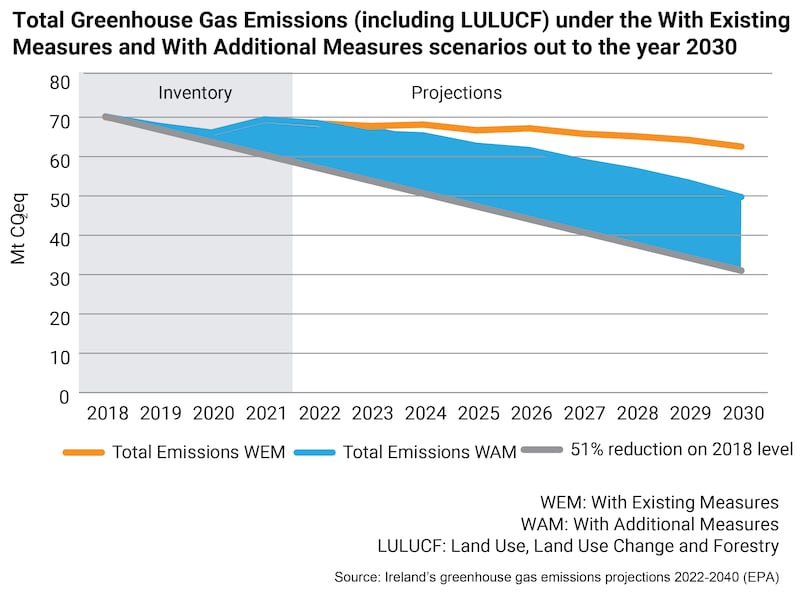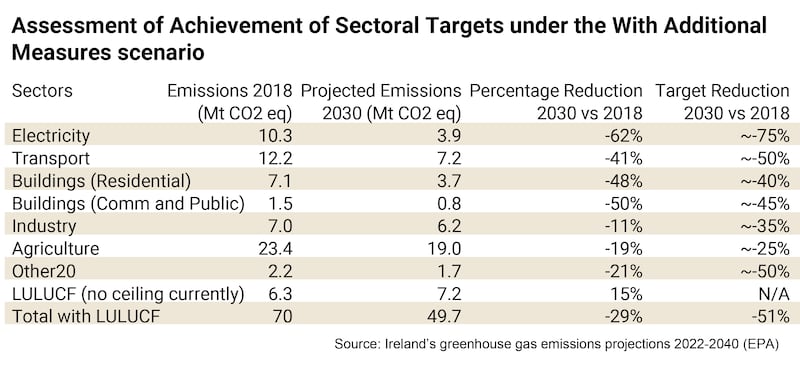Tánaiste Michéal Martin has said that the environmental measures the Government has put in place in the past two and a half years will “take time to bear fruit” following projections by the Environmental Protection Agency (EPA) that the country will miss its legally-binding climate targets by a wide margin.
The Tánaiste said another challenge facing the country’s climate action is its growing population.
“Historically we were underpopulated, that has changed. we’re now growing significantly as the census reveals to 5.1 million. That greats its own pressures on reaching these targets and economic growth has been very strong over the last couple of years, and so that creates its challenges in terms of emissions reductions,” Mr Martin said.
“We’ve put in very, very challenging targets and perhaps the previous ten years we didn’t move fast enough in respect of the emissions reduction agenda. But that said, there are some areas that have not yet been modelled that have proposed in respect of the assessments,” the Tánaiste said.
READ MORE
“I think we can gain in terms of some of the actions that haven’t quite been taken into account, but I don’t underestimate the challenge ahead of us in respect of reducing emissions, but we have to do it in terms of sustainably globally, but also in terms of better quality of life as well.”
Speaking in Phoenix Park at Bord Bia’s Bloom festival, Mr Martin added that we can “see the impact of climate change now in terms of weather and in terms of the impact that it will have on food production and on the sustainability of life on our planet”.
Speaking earlier at Bloom, Taoiseach Leo Varadkar said Ireland was “ahead of the world” in terms of legislation on climate action but “what we really need to focus on now is implementation and execution”.
Asked did he accept the Government was not going to hit targets, he said: “No, we are not conceding that,” adding progress was being made in some areas.
Minister for the Environment Eamon Ryan said Ireland is “turning the ship around” despite the EPA’s warning that the Government is falling far short of legally-binding targets.
“The EPA projections today make for sobering reading. They leave us in little doubt that Ireland has a steep challenge ahead of us if we are to make our national and European climate targets. However, it’s not all negative.
“While the 29 per cent projection is not where we need to be, it does indicate that we are turning the ship around and that we are going in the right direction. The projections must be seen as an incentive now to act even more urgently,” Mr Ryan said.
[ Ireland to miss 2030 climate targets by wide margin, EPA predictsOpens in new window ]
The EPA report shows Ireland will achieve a reduction of only 29 per cent in its greenhouse gas emissions by 2030, well below the legally-binding target of 51 per cent that is core to the Government’s climate policy.
Almost all sectors are on a trajectory to exceed their national ceilings – including agriculture, industry, electricity and transport.
Mr Ryan said: “We need to be much faster and more ambitious, particularly in how projects get through the planning system. We also need stronger political commitment to climate action at all levels – in local politics, at a national level and in Europe.
“I think we can, and we will, grasp the climate nettle as the EPA puts it. We will do so because it will be good for Ireland, delivering green jobs, green energy, green agriculture and ensuring that our economy and our natural environment is secure for generations to come.
“I also think we can do it because the projections, while an important warning bell, do not tell the full story. They do not take account of high impact actions that the EPA cannot yet model and they do not include the unaccounted for emissions reductions we have allocated to areas like land use. I believe, and indeed the EPA itself suggests, that with these additions, we could get much closer to our targets.
“However, nothing takes away from the need to up our game,” the Green Party leader added.


Stop Climate Chaos coalition coordinator Sadhbh O’Neill described the findings as “deeply disturbing”, noting that the Dáil had set legally binding limits on polluting emissions to 2025 and 2030, on a cross-party basis.
“It’s not good enough to rely on rhetoric and wishful thinking. It is not acceptable to point to a target as if that is the same thing as meeting it. Climate action means ending our dependence on fossil fuels, ramping up renewables, shifting out of cars to public transport and active travel, and urgently cutting livestock numbers and synthetic nitrogen fertiliser use,” she said.
Friends of the Earth chief executive Oisín Coghlan described the EPA projections as a “stark warning” and “the kick in the backside the Government needs”.
Marie Donnelly, chairwoman of the Climate Change Advisory Council said “each sector needs a detailed emissions trajectory now, setting out how the sectoral emissions ceilings will be achieved.”
Actions that would have an immediate impact include acceleration of the roll out of solar power on commercial and public sector buildings; rapid increase of the use of newer fertilisers in agriculture; and a continued reduction in public transport fares to support a modal shift and behavioural change, she said.
The EPA modelling shows planned climate policies and measures, if fully implemented, could deliver up to 29 per cent emissions reduction by 2030 compared with 2018; a reduction of 4 per cent each year from 2022 to 2030. This is insufficient to meet requirements of the Climate Act.
Ireland has committed to a 51 per cent reduction in its greenhouse gas emissions by 2030. However, two scenarios modelled by the EPA outline how in fact the amount of greenhouse gas emitted will be exceeded by between 24 and 34 per cent. If existing measures which were adopted and resourced until the end of 2021 are implemented, the scenario shows the biggest shortfall in terms of meeting our climate budget. If more ambitious measures are adopted as those outlined in the 2023 climate plan, there will be a better outcome, albeit short of what is required.













